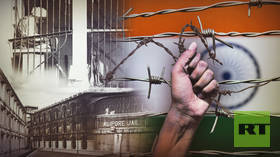NATO storing tanks & military hardware in Cold War-era Norwegian caves
NATO is deploying tanks and military equipment to a series of caves in Norway. They have been largely redundant since the end of the Cold War, but now the alliance is stocking up on hardware, which will be deployed near NATO’s border with Russia.
It may seem like something from a James Bond movie, but NATO has been operating a slick operation in hillside caves built in the Norwegian countryside for decades. However, now the US-led alliance feels it is time to beef up its military presence, to prepare for what it perceives as a Russian threat.
“We have prepositioned gear both in caves and on ships and it allows forces from the United States to come out and fall in on gear that is already forward deployed versus bringing all that gear with us,” William Bentley from the 2nd Marine Expeditionary Brigade said in a video released by the US Marine Corps Forces Europe and Africa last week.
Amongst other things, the caves, which are classified, will be equipped with M1A1 Abram tanks, and amphibious assault vehicles, in order to make sure NATO is prepared for any potential crisis.

The cave complex is staffed by around 100 Norwegian and US personnel, while it contains enough equipment to support in the region of 15,000 marines, CNN reports.
NATO plans to undertake a training exercise in the not too distant future called Cold Response 16 and will use some of the 6,500 pieces of equipment stored in the cave for the drills.
“It always takes time to deploy forces to a certain area. When you have material equipment pre-positioned, you can fly in personnel and it will be faster ready to conduct operations,” Major General Yngve Odlo, Chief of Norwegian Defense Staff Operations said, adding that Norway’s forces had been working with their US colleagues for the last 10 to 15 years in places like Afghanistan.
On Tuesday, President Barack Obama said that the Russian armed forces are “the second-most powerful military in the world,” although just two years earlier he had described Russia as nothing more than a “regional power.”
Meanwhile, US Defense Secretary Ashton Carter said in November that Russia was challenging “American preeminence” and Washington’s so-called “stewardship of the world order.”
While Russia is concerned about NATO’s military build-up along its borders, Moscow has said it would be “insane” to even consider an attack on a country allied to the alliance.
“I think that only an insane person and only in a dream can imagine that Russia would suddenly attack NATO. I think some countries are simply taking advantage of people’s fears with regard to Russia,” said President Vladimir Putin in June.
However, this is not stopping NATO from pushing ever closer to Russia’s borders. Washington has already announced plans to quadruple spending for its military presence in Europe to $3.4 billion to ‘deter’ Russia’s ‘aggression’.

On February 10, NATO Defense Ministers agreed on an enhanced forward presence “in the eastern part of our Alliance,” according to NATO Secretary General Jens Stoltenberg.
In November, Norway welcomed the first two of 22 Lockheed Martin’s F-35 fighter jets, which it sees as a counter measure to what Oslo considers Russia’s boosting military capabilities in the region. Each plane costs in the region of $150 million.
“The last time I can remember there was this kind of hostile military force on Russia’s borders is when the Nazi’s invaded Russia in 1941,” Stephen Cohen, a Professor of Russian studies at New York University, told RT
“There has never been anything like this. Russia is not threatening any country along its border and is not turning European countries against each other. But we know the Russian reaction. My kids know the Russian reaction – it’s a tit for tat as we lived through the last Cold War,” he added.
In November, Norway welcomed the first two of 22 Lockheed Martin’s F-35 fighter jets, which it sees as a counter measure to what Oslo considers Russia’s boosting military capabilities in the region. Each plane costs in the region of $150 million.














